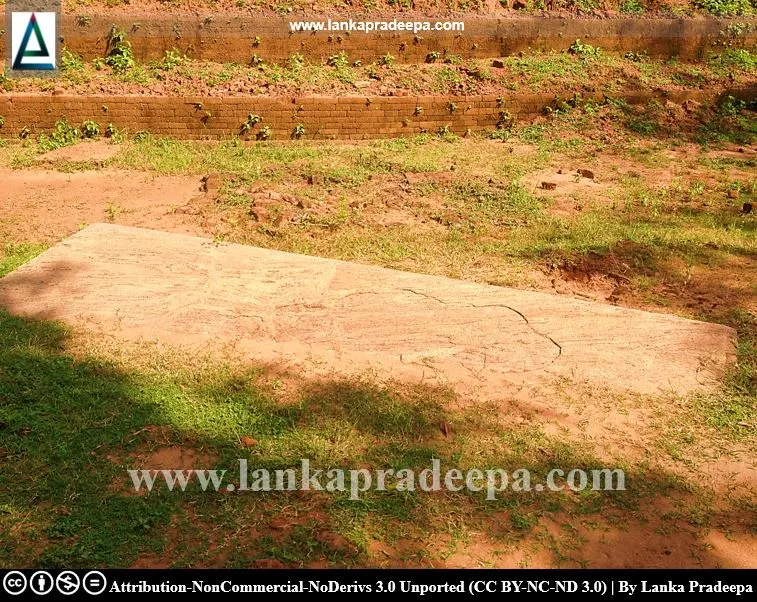
|
Neelagiri Stupa during the coservation |
Neelagiriseya (Sinhala: නීලගිරිසෑය) is an ancient gigantic Stupa located in the woods of the Lahugala-Kitulana National Park in Ampara District, Sri Lanka.
History
Archaeological evidence has confirmed that Neelagiriseya was in existence from the 2nd century B.C. A rock inscription belonging to the reign of King Kutakannatissa (44-22 B.C.) that was discovered on this premises reveals the old name of this monastery as Uttara Seevali Pabbata Viharaya (Kodithuwakku, 2022). Another rock inscription belonging to the period 3-4 century A.D. records that this monastery received the patronage of a King titled Jetthatissa [(probably King Jetthatissa II: 328-337 A.D.) Kodithuwakku, 2022].
Although the origin of this temple is not clearly known, there are several views about its establishment. According to one of such views, this is the ancient Pasanadipika Viharaya built by King Mahadathika Mahanaga [(9-21 A.D.) Nicholas, 1963; Withanachchi, 2013]. However, some authors believe that this is a work of King Suratissa [(247-237 B.C.) Medhananda, 2003; Withanachchi, 2013].
A few scholars such as Rev. Handupelpola Punnyarathana, hold the view that this Stupa could be the Mahanuggala Stupa built by King Kavantissa (205-161 B.C.) which is mentioned in the great chronicle, Mahawamsa (Somadeva, 2011). Rev. Ellawala Medhananda has quoted the same opinion in his book 'Pācīna passa – uttara passa, nägenahira paḷāta hā uturu palātē Siṃhala bauddha urumaya' (Medhananda, 2003; Somadeva, 2011). If it is true, this is the temple where King Kavantissa had made the ten giants swear never to pick sides in a war between his two sons, Gemunu and Tissa (Medhananda, 2003).
According to an inscription belonging to the reign of King Mahasen (277-304 A.D.), this institute had been called at the time Kulabariya Maha Vehera (Withanachchi, 2013). That inscription records a donation of Kahawanu to the aforesaid temple for the ceremonies named Ariyawamsa (Withanachchi, 2013).
Inscriptions
During the excavations done at the site recently, archaeologists found a few rock inscriptions within the monastery premises (Somadeva, 2011). The oldest of them belongs to the reign of King Kutakannatissa [(44-22 B.C.) Kodithuwakku, 2022]. It records a decree proclaimed to a monastery named Uttara Seevali Pabbata Viharaya by Chula Seeval Devi, the queen of Bhatikatissa [(reigned: 22 B.C.-7 A.D.) Kodithuwakku, 2022; Somadeva, 2011]. The inscription has been engraved during the period of Bhatikatissa when he was a viceroy (Uparaja) in Ruhuna (Kodithuwakku, 2022). Therefore, this inscription can be assigned to the period of King Kutakannatissa, the predecessor of King Bhatikatissa (Kodithuwakku, 2022; Somadeva, 2011).
Another rock inscription at the site also records a decree announced by a king named Jetthatissa (Kodithuwakku, 2022). Here the king's name, according to scholars, could be either King Jettatissa I (263-273 A.D.) or Jettatissa II [(328-337 A.D.) Kodithuwakku, 2022; Somadeva, 2011]. According to the view of Kodithuwakku, this king is no other than Jettatissa II (Kodithuwakku, 2022).
A slab containing nine Later Brahmi Scripts of the 1st century A.D. was discovered among the ruins of the dilapidated Stupa mound during the excavations carried out between 2011-2014 (Kodithuwakku, 2022).
The Stupa
From the archaeological evidence found so far, this structure had been constructed during the pre-Christian era. The layer of stone which makes the Stupa pavement is said to belong to the 7th century A.D. The Yupa-stone and the basal rings are made of stone and bricks.
Presently, the Stupa is 73 feet (22.25 m) in height and has a circumference of 629 feet [(191.71 m) Wijerathna et al., 2018; Withanachchi, 2013]. However, according to the studies, the height of the present Neelagiri Stupa is not complementary with the size of the circumference of its base and represents only about one-third of its complete/original height (Wijerathna et al., 2018; Withanachchi, 2013).
Restoration
The restoration work of Neelagiri Stupa was started in 1960 but it became unsuccessful due to the terrorist activities of LTTE (Liberation Tigers of Tamil Eelam) around the Lahugala region. The Stupa was opened only after 2010 and restoration work was begun again in 2011 (Wijerathna et al., 2018). During the excavations, small Stupas with a bubble shape and paddy-heap shape were found from the site (Wijerathna et al., 2018).
A Protected Site
Neelagiri Dagaba and the adjoining premises with buildings with stone pillars in inscriptions and sites with archaeological ruins, cave complex with cave inscriptions and pre-historical arts situated in Perani Lahugala PP 10 Grama Niladari Division in the Divisional Secretary’s Division, Lahugala are archaeological protected monuments, declared by a government Gazette notification published on 10 October 2014.


Related Posts
Read Also
References
Books, Government Gazette Notifications, Journal Articles
1) Kodithuwakku, N., 2022. අභිලේඛන සංග්රහය-1 (Abhilekhana Sangrahaya-1). Department of Archaeology. ISBN: 978-624-5840-17-4. pp.8-16.
2) Medhananda, Ven. E., 2003. Pacheena passa - Uttara passa: Negenahira palata ha uturu palate Sinhala bauddha urumaya (In Sinhala).
Dayawansa Jayakody & Company. Colombo. ISBN: 978-955-686-112-9. pp.115-119.
3) Nicholas, C. W., 1963. Historical topography of ancient and medieval Ceylon. Journal of the Ceylon Branch of the Royal Asiatic Society, New Series (Vol VI). Special Number: Colombo. Royal Asiatic Society (Ceylon Branch). p.22.
4) Somadeva, R., 2011. The Archaeological Survey in Neelagiri seya Area in Lahugala of Ampara District: Neelagiriseya Survey: The interim report. Postgraduate Institute of Archaeology. pp.1-23.
5) The Gazette of the Democratic Socialist Republic of Sri Lanka. No: 1884. 10 October 2014. p.917.
6) Wijerathna, W.H.T.S., Ranasinghe, R.A.M.P. and Karunananda, P.A.K., 2018. Structural Assessment and Restoration of Neelagiri Maha Seya in Ampara, Sri Lanka. OUSL Journal, 13(2). pp.101-123
7) Withanachchi, C. R., 2013. Pauranika Sthana Saha Smaraka: Ampara Distrikkaya (In Sinhala). Department of Archaeology (Sri Lanka). ISBN: 955-9159-44-5. pp.21-23.
Location Map
Dynamic Google Map
Attribution
To Whom
LankaPradeepa.com extends its gratitude to Malsha M. Ranasinghe for providing the necessary photographs required for this article. All the photos are published here with the permission of the author.




